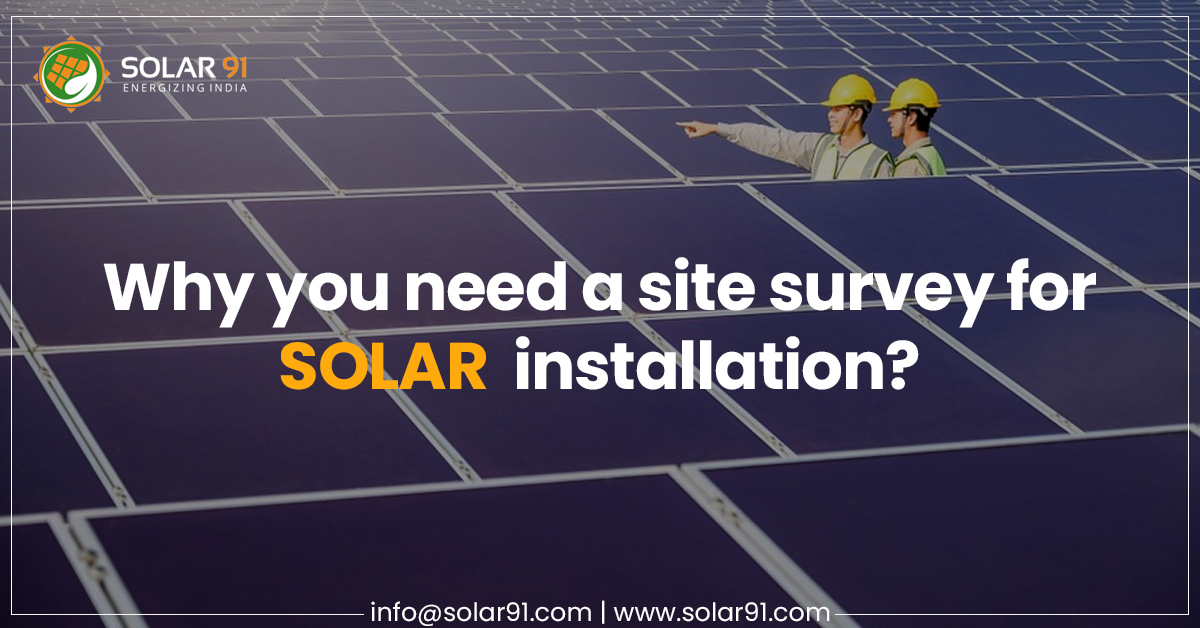Why you need a site survey for solar installation?
Solar energy is the need for the hour, living a better life is getting costlier every day, and people are suffering because of the ever-rising electricity bills, which dig a big hole in your monthly budget and make you reduce the amount of money you might spend eating better food, buying new stuff, appliances or whatnot. Solar energy can significantly reduce the problem of worry for your electricity bills by just a one-time investment which too, in most cases, is subsidized by the state up to a reasonable extent.
Solar Energy helps reduce your carbon footprint because it cuts the use of non-sustainable energy sources such as coal and hydroelectricity.
If you are looking to get a solar system installed this summer, you must know some crucial things before installing it. One of these essential things is the site survey where the installer company executive visits the house and takes an overview of the place where the system needs to be installed. This survey is crucial, and you can ask your queries about the installation better.
The question that arises is why you need a site survey for solar installation? Let’s solve it.
Why is Site Survey important for solar installation?
With a Site survey before solar installation, you can ensure that your house is getting the perfect solar setup and save yourself from future trouble and maintenance issues. This also gives you a better idea of the cost of installations and eliminates payment issues.
With a site survey, the technician can check if there are any obstructions near the house that can influence the solar panels’ working, like tall trees. They reduce the amount of sunlight falling on your solar panels and hence reduce the power generation.
Below mentioned are several other important reasons for a site survey:
Roof Structure Analysis
One crucial factor during the installation of solar at your house is the Roof structure, uneven structure, lack of space, and many factors that can create trouble. The 4 factors analyzed are:
- Rooftop Surface area
- The angle of incline of Roof
- Roof direction
- Type of construction material used in Rooftop
The information collected during rooftop analysis is:
- Building ownership ( Owned / Leased / apartment )
- Shadow free Rooftop part to be used for solar setup/Wind set up (in square ft) Approximate.
- Building height
- Information of lease structure (if leased) (lease duration, No of parties.)
- Coordinates of site (latitude & Longitude) ( non-compulsory )
- Roof type
- Most Load ability of the Roof – if to be had (kg/m2)
Financial Analysis
The government is constantly trying to evaluate sustainable ways of power and energy generation, which they, up to a great extent, have been able to find in Solar power. This is why the government is incentivizing solar installation by giving out subsidies and grants for the installation. During the site survey, you can question the installer about the availability of any government subsidies and also the information about other costs involved in the installation.
Solar Panel Orientation
This might look unimportant, but you would be amazed to know that the orientation of your solar panels can increase the power generation by more than 50% and vis a vis. During the installation, the technician should make sure that the panels get maximum solar exposure.
Shade free installation
A shade-free installation boosts the power output up to a great extent. If any building, tall tree, or wall is obstructing sunlight due to the lack of intensity, the power generation falls and is slow. To ensure a shade-free installation, many methods and tools are used, like Solar shading tools, Microinverters, and trackers.
Load analysis
This is a crucial part of the process since it ensures that an adequate number of solar panels are installed. Load analysis is done by analyzing the readings of your previous electrical consumptions. Also, a list of all the big and small power-consuming appliances is taken for a better idea. Several other factors such as sanctioned load, Number of power cuts every month, consumer category are also analyzed.
Conclusion
You can do your part in saving the environment by adapting Solar power to your lifestyle. Many people have been free from their electricity bills and even making some money by selling the excess electricity generated to the state. Solar panels have low maintenance costs, and they are weatherproof too. The top layer of solar panels needs to clean once to remove the excess dua that gets deposited, interrupting the process. If the sunlight in your locality is intense and powerful enough, you can run heavy appliances directly from the sun.

